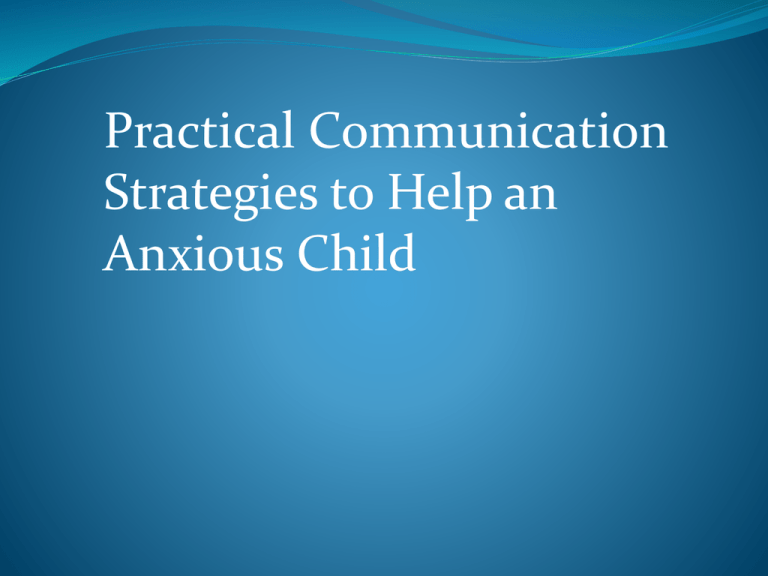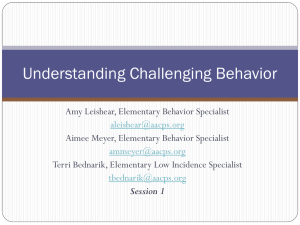Strategies to Help an Anxious Child
advertisement

Practical Communication Strategies to Help an Anxious Child Program Objectives Identify the behavior levels that contribute to the development of a crisis and choose an appropriate intervention Indentify useful nonverbal techniques which can help to prevent escalating behaviors Crisis Development Model Crisis Development/Behavior Level Staff Attitude/Approach 1. Anxiety Anxiety: A noticeable increase or change in behavior (pacing, finger drumming, wringing of the hands) Crisis Development Model Crisis Development/Behavior Level Staff Attitude/Approach 1. Anxiety 1. Supportive Anxiety: A noticeable increase or change in behavior (pacing, finger drumming, wringing of the hands) Supportive: An empathetic, nonjudgmental approach attempting to alleviate anxiety Crisis Development Model Crisis Development/Behavior Level Staff Attitude/Approach 1. Anxiety 1. Supportive 2. Defensive Defensive: The beginning stage of loss of rationality. At this stage, an individual often become belligerent and challenges authority. Crisis Development Model Crisis Development/Behavior Level Staff Attitude/Approach 1. Anxiety 1. Supportive 2. Defensive 2. Directive Defensive: The beginning stage of loss of rationality. At this stage, an individual often become belligerent and challenges authority. Directive: An approach in which a staff member takes control of a potentially escalating situation by setting limits. Crisis Development Model Crisis Development/Behavior Level Staff Attitude/Approach 1. Anxiety 1. Supportive 2. Defensive 2. Directive 3. Acting-Out Person Acting-Out Person: The total loss of control, which results in a physical acting out episode Crisis Development Model Crisis Development/Behavior Level Staff Attitude/Approach 1. Anxiety 1. Supportive 2. Defensive 2. Directive 3. Acting-Out Person 3. Nonviolent Crisis Intervention Acting-Out Person: The total loss of control, which results in a physical acting out episode Nonviolent Crisis Intervention: Safe, non-harmful control and restraint positions to safely control an individual until he/she can regain control of his/her behavior (used as a last resort when the child presents a danger to self/others. Crisis Development Model Crisis Development/Behavior Level Staff Attitude/Approach 1. Anxiety 1. Supportive 2. Defensive 2. Directive 3. Acting-Out Person 3. Nonviolent Crisis Intervention 4. Tension Reduction Tension Reduction: A decrease in physical and emotional energy that occurs after a person has acted out, characterized by the regaining of rationality. Crisis Development Model Crisis Development/Behavior Level Staff Attitude/Approach 1. Anxiety 1. Supportive 2. Defensive 2. Directive 3. Acting-Out Person 3. Nonviolent Crisis Intervention 4. Tension Reduction 4. Therapeutic Rapport Tension Reduction: A decrease in physical and emotional energy that occurs after a person has acted out, characterized by the regaining of rationality. Therapeutic Rapport: An approach used to re-establish communication with an individual who is experiencing Tension Reduction. Nonverbal Behavior Objectives Raise awareness of nonverbal communication during interventions Illustrate how personal space (proxemics) affects anxiety levels Illustrate how body posture and motion (kinesics) affects anxiety levels Proxemics (Personal Space) An area surrounding the body (1.5 – 3 feet) which is considered an extension of self Personal space varies depending on who is approaching and what the context of the situation happens to be. Factors include: gender, size, age, cultural background, relationship, health, previous experiences Invasion of personal space will increase anxiety Includes someone’s “stuff” Kinesics (Body Posture/Motion) The nonverbal message transmitted by the motion and posture of the body Facial expressions, gestures, posture, movement Staff member’s kinesics behavior can serve to escalate or de-escalate a given situation. A body position that appears challenging or confrontational may increase anxiety when approaching an individual. Supportive Stance Communicates respect Nonthreatening/Non-challenging Contributes to personal safety Paraverbal Communication Definition: The vocal part of speech, excluding the words Component Suggested Approach 1. Tone a. Try to avoid inflections of impatience, condescension, inattention, etc. 2. Volume b. Keep the volume appropriate for the distance the situation 3. Cadence c. Deliver your message using an even rate and rhythm Empathic Listening • Be nonjudgmental • Give undivided attention • Listen carefully to what the person is really saying – and not saying (focus on feelings, not just facts) • Allow silence for reflection • Use restatement to clarify messages











